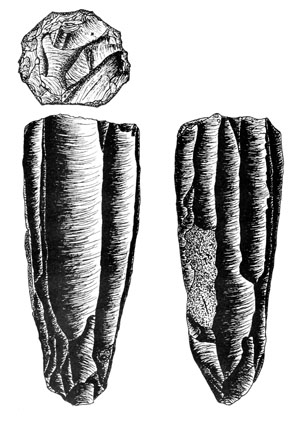Cards In This Set
| Front | Back |
|
Neanderthal
|
 Heavy brow ridge, larger oxipital bun, reduced size of forehead, more space between molars |
|
Progressive Neanderthal
|
Shorter, higher cranium
reduction in relative size of face and teeth |
|
Cro-Magnon
|
 France 24-28,000 bc -thought to be Aurignacian, but actually Gravettian -high forehead, small eyebrow ridges -face reduced in size compared to Neanderthals, prominent chin -not as muscular as Neanderthals |
|
Innovations in Stone Technology
(Blade technology) |
Blade tools, but core tools still present
-blade technology: one of most important tech. innovations made by early modern Homo sapiens (more efficient use of stone tool raw material) |
|
Discoid core
|
 Short, irregular flakes (Mousterian core) |
|
Blade core
|
 Long, narrow flakes with parallel sides, carefully prepared striking platform |
|
Blade
|
 X2 as long as they are wide |
|
Antler punch
|
 For 'indirect percussion' -greater control, increased quality and efficiency of blade production |
|
Pressure flaked projectile point
|
 Pointed bone flaker used to press small, thin flakes from edge of tool -finishing techniques (finely balanced spears and arrowpoints) |
|
Cognitive Leap (Upper Paleo)
|
45-35,000 BP
capacity for complex culture evolved before actual development -European adaptation to extreme cold of late Pleistocene (big game hunting and fishing) -clothing, eloborate shelters -all tools made on blades or blade segments |
|
Endscrapers (Upper Paleo)
|
 -most common tool -working edge opposite of platform -used to prepare leather |
|
Burins
|
 Chisel tip, carving wood, bone, antlers |
|
Chatelperron Point
|
 Backed knife, linked to Mousterian (?) |
|
Solutrean "Laurel Leaf" point
|
 Large, finely made points or knives (France and Spain) -may have been ceremonial (fragile and large) |
|
Bone technology and Ornaments
|
Carved with knives, burins or ground using natural abrasives such as fine sand
|



